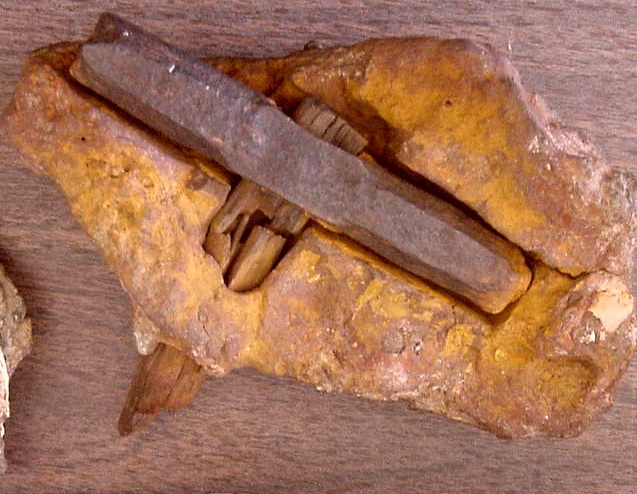The “London Hammer” is an interesting artifact that has sparked some pretty heated debate since its initial discovery.
In 1936, Emma Zadie Hahn and her husband Max Edmond Hahn were taking a stroll along a creek near London, Texas when they stumbled upon something quite out of the ordinary – a rock with a piece of wood sticking out of it. Little did they know, this unassuming find would go on to capture the imagination of people for decades to come, leading to some interesting theories as to how it came to be.

When the couple’s son broke open the rock about 10 years later, he discovered something even more perplexing – a modern looking metal hammerhead embedded inside the rock. By all appearances, it seemed to be a modern tool trapped in an ancient geological formation. But how could this be possible?
The hammer itself has a metal head and a wooden handle, which suggests a relatively recent origin, probably from the 19th century. However, the rock encasing it was purported to be over 100 million years old, according to some interpretations, leading to speculation that the hammer might be a so-called “oopart” — an out of place artifact that challenges conventional historical timelines.
The artifact, dubbed the “London Hammer,” quickly attracted the attention of Young Earth creationist Carl Baugh, who saw it as potential evidence that humans and dinosaurs had coexisted in the distant past. Baugh purchased the hammer in the 1980s and began promoting it at his Creation Evidence Museum, claiming it dated back to the Cretaceous period – a time when humans were supposedly not yet evolved.
“If the artifact is truly from the Cretaceous time frame, where does this leave evolutionary theory, since man was not supposed to have evolved for another 100-million years or so?” Baugh asked. He theorized that the Cretaceous rock formation it was found in must therefore be much younger than mainstream science suggests.
The London Hammer was discovered by hikers in Texas, in 1936. It was embedded in a limy rock concretion originating from the Cretacious rock formation, 400 million years ago! The hammerhead is 6 inches long with an 1 inch diameter. pic.twitter.com/xd9AIgkdoM
— KevinPinball (@KevinPinball) July 6, 2023
However, as geologists have pointed out, the evidence tells a rather different story. The nodule containing the hammer is not actually part of the ancient bedrock, but rather a more recent concretion – a rock-like formation created when dissolved minerals precipitate around an object.
“The stone is real, and it looks impressive to someone unfamiliar with geological processes,” explained investigator Glen J. Kuban. “How could a modern artifact be stuck in Ordovician rock? The answer is that the concretion itself is not Ordovician. Minerals in solution can harden around an intrusive object dropped in a crack or simply left on the ground if the source rock…is chemically soluble.”
In other words, this 19th century miner’s hammer likely got lost or discarded, only to become encased in a limey rock deposit over the course of decades or perhaps a century. It’s a fascinating bit of geological happenstance, but hardly the revolutionary discovery Baugh made it out to be.
While the “London Hammer” makes for an intriguing conversation piece, it’s ultimately nothing more than an old tool quite literally cemented in time. The real mystery is how it managed to fool so many people into thinking it was something far more extraordinary.

